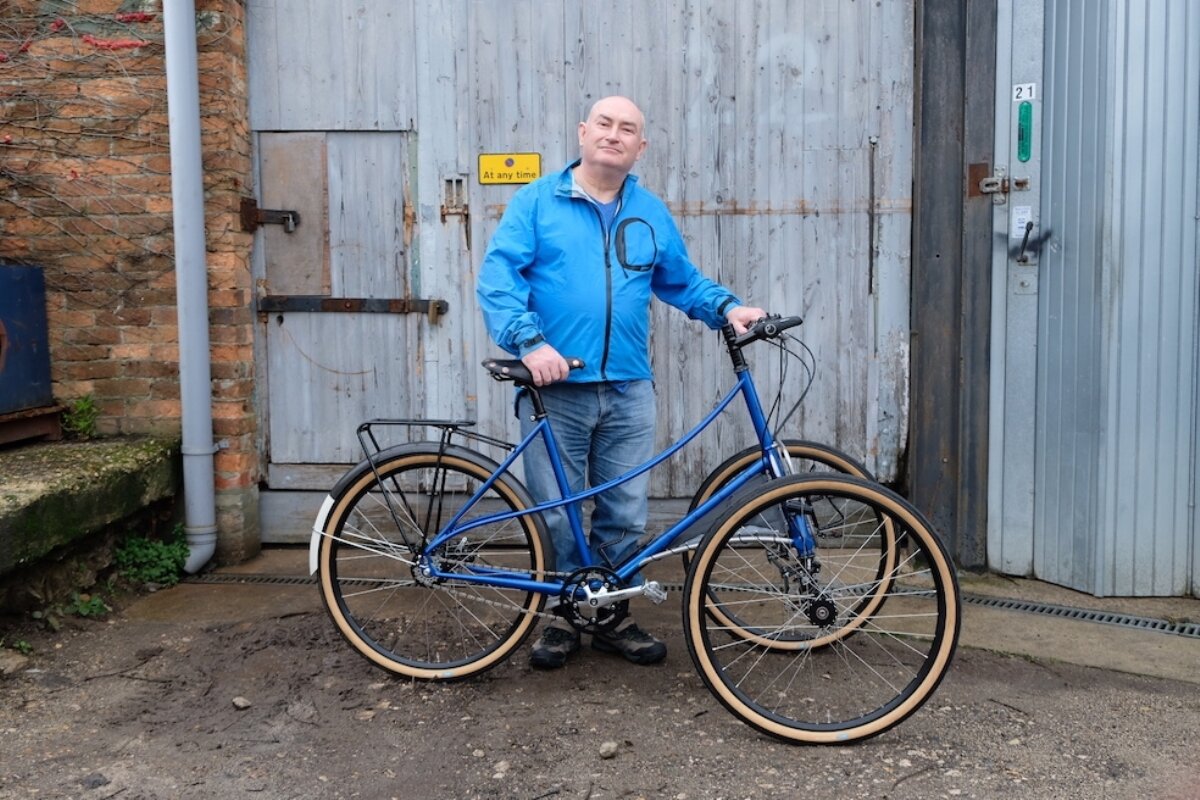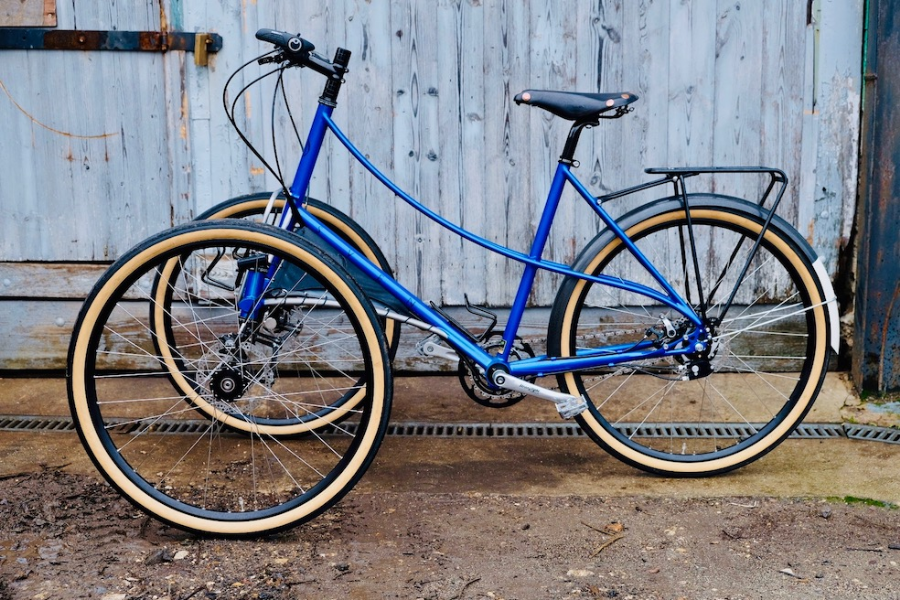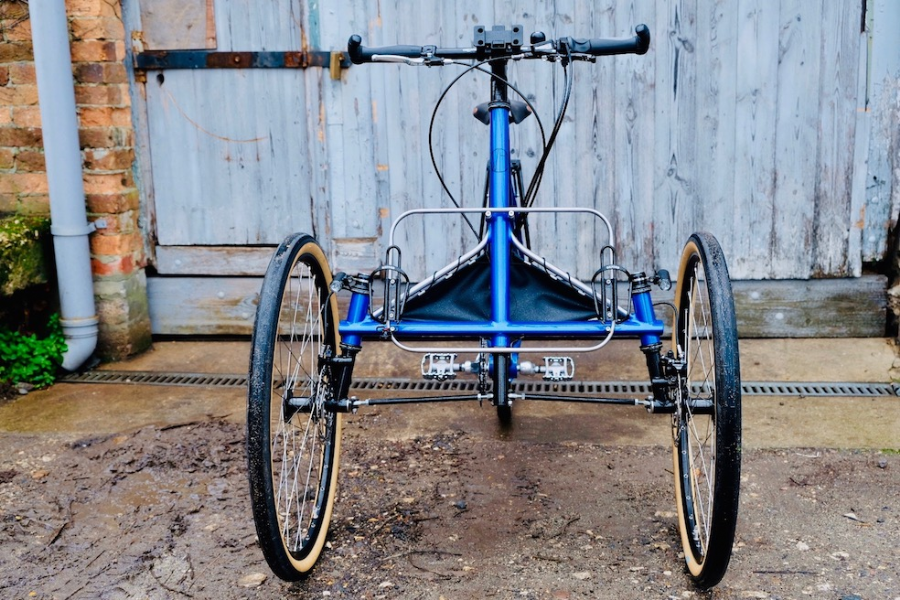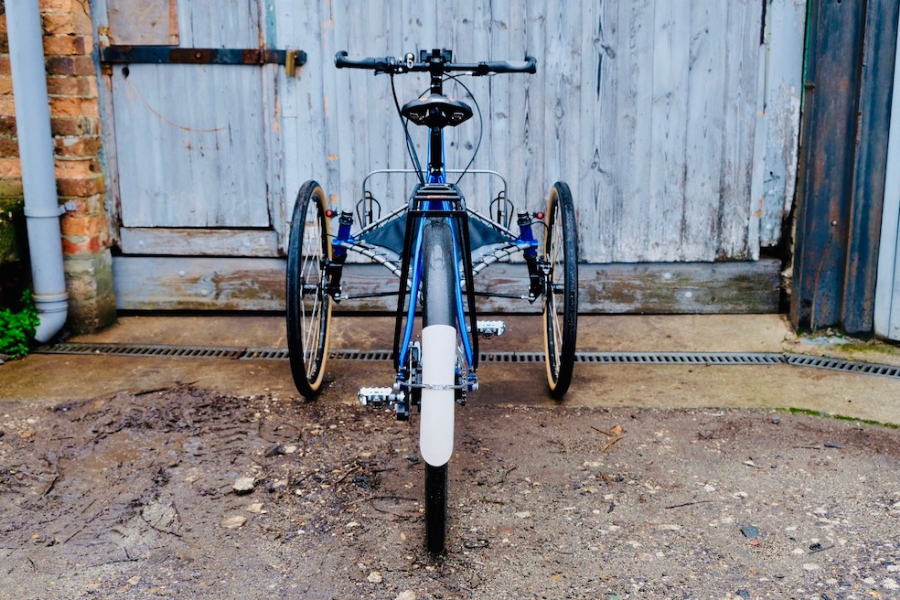Stingray Tricycle
Awarded the Cycling UK Choice award at the 2019 Bespoked Festival
In late 2017 Peter contacted us and asked if we would be interested in building him a Newton tricycle. For those who don't know a Newton (sometimes called a Tadpole) tricycle has two front wheels and one rear wheel.




The advantages of the Newton layout mean the rear of the tricycle is the same as a bicycle and doesn't need any special parts for the drive train. The front, on the other hand, is very different and requires careful design to get the handling correct, as well as special hubs.
It was a steep learning curve, but after much consideration, redrawing, building prototypes and testing we arrived at what became The Stingray. Phil Wood made us the front hubs, a Rohloff Speedhub provided the gearing, Hope hydraulic brakes (two brakes from one lever) stop the trike and a cable-operated rear disc brake with a BMX freestyle lever act as a parking brake.
The frame is made of a mix of Reynolds 853, 631 tandem tubing and stainless steel. The steering parts were made in our workshop in stainless steel and use racing go-kart con rods to connect everything together.
The custom frame bag was made for us by Moatt Sails, a local sailmaker.
The Birth of The Stingray Trike
Peter's story in his own words: I have always been keen on cycling ever since I received my first real bike in the late 1960's - a Molton Mini with its Sturmey Archer 3 Speed Hub Gear. However, changing gear has always been a challenge for me as since my birth I have been living with limited dexterity in my right hand. The solution when I was young was to the mount the Sturmey Archer gear lever back to front on the left side of the handlebar, not elegant but practical.
As I progressed to bigger bikes with different gear arrangements, a 5-speed derailleur with the gear lever on the down-tube meant that a simple solution was to use my left hand reaching through the frame to change gear. This same approach was adopted as the number of gears increased and the introduction of the double and triple chain rings, as long as the gear levers remained on the down-tube, the solution of using my left hand through the frame to change gear was simple, relatively safe and straight forward.
As technology moved forward the method of changing gear became more integrated with other components on the bike. Firstly the bar-end gear shifters, then integrated on the handle bars, and finally into the brake levers, it became more and more difficult and unsafe to change gear while riding.
About 7 or 8 years ago it was time for a new bike. I started to investigate to see if there were any properly-engineered solutions that provided the main gear change function on the left hand side of the handle bars. To my amazement I could not identify a solution - until I happened to come across the Rohloff Speedhub which offered a left-handed gear change. I therefore had my solution for my next bike that would allow me to continue to ride safely and with confidence that I would remain in full control of the bike while changing gear.
Now that I had identified a solution to the gear change issue I started to research the best Rohloff Speedhub bike on the market that met my requirements. While doing this research I suffered another setback to that goal. I started to get pain in my hip which started to affect my pleasure of cycling and in the end the solution was to have a hip replacement operation.
Following the operation the consultant advised I should consider giving up cycling on the road and restricting my cycling to a fixed bike in a gym or a fixed training bike to avoid the possibility of any damage to the replacement hip due to falling or being knocked off the bike. The prospect of not getting out on the road in the fresh air did not appeal to me at all. When I did try and ride a bike on the road following the operation I found that I had lost my confidence to ride on two wheels safely and therefore I needed a new approach.
After some thought the idea of a trike developed to resolve the issue of the confidence while riding as the trike provided a stable platform. But how to incorporate the Rohloff Speedhub to give me the left handed gear change that I required? After during some research on the internet it came down to two approaches: either modify a two wheel at the rear transmission system to include a Rohloff Hub instead of a standard derailleur system, or use a Rohloff Speedhub as the transmission system in a ‘two-wheel-at-the-front’ trike. My preference was to go for this set-up (Tadpole Configuration) as a standard rear wheel transmission could be utilised and it would be a more stable platform, especially for touring.
I approached a couple of frame builders with my requirements, that I knew had built trikes in the past, but unfortunately I didn't get any positive responses so I began to fear that getting back on the road would be a distant dream. I thought I would give it one more try and changed tack to look for Frame builders that built frames around the Rohloff Speedhub as the transmission system. My search returned the Sven Cycles website and, being located relatively close to where I was, I decided to drop them an e-mail with my requirements. Within a day I had received a response from Darron that the team were interested in my challenge and a couple of weeks later I was sitting down with the team at Sven Cycles discussing my requirements for the trike.
Following my visit I soon received a quote to which I agreed and then it was over to the Sven Team to design and manufacture the trike to my requirements, which since became known as the 'Stingray' due to the shape created by the bespoke stowage bag that fits in between the front horizontal and vertical frame stays.
The Stingray was awarded the Cycling UK Choice award at the 2019 Bespoked Festival of UK Hand-made bicycles.
More info here: https://bespoked.cc/awards.html

